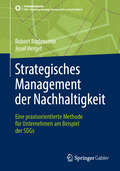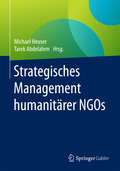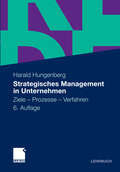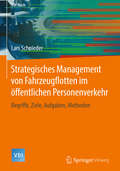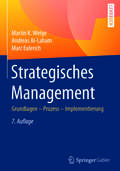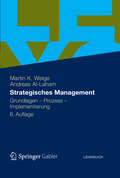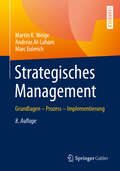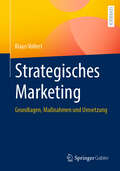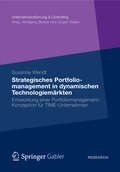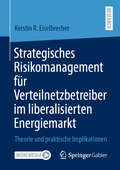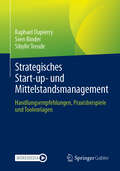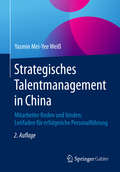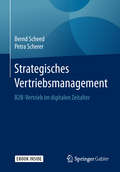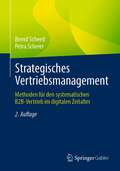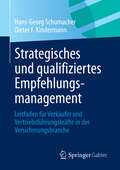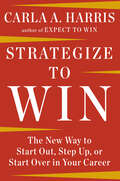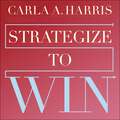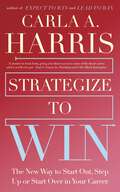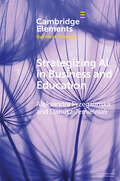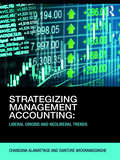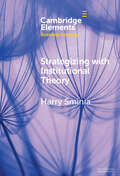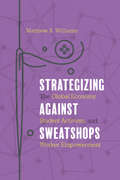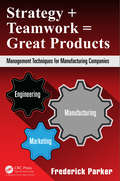- Table View
- List View
Strategisches Management der Nachhaltigkeit: Eine praxisorientierte Methode für Unternehmen am Beispiel der SDGs (SDG - Forschung, Konzepte, Lösungsansätze zur Nachhaltigkeit)
by Josef Herget Robert BodensteinDieses Buch setzt sich mit der konkreten Umsetzung von Nachhaltigkeitsstrategien in Unternehmen auseinander. Damit die Strategie wirkungsvoll umgesetzt werden kann, wurde eine modellbasierte Methode entwickelt, die einen ganzheitlichen Ansatz ermöglicht, ohne dass die Komplexität den Blick für das Wesentliche verstellt. Das vorgeschlagene Konzept der Nachhaltigkeits-Exzellenz stellt eine Vorgehensweise zur Verfügung, die sowohl Herausforderungen in großen Unternehmen als auch begrenzte Ressourcen in kleinen Unternehmen berücksichtigt. Die entwickelte Methode eignet sich für alle gewählten Konzepte zur Nachhaltigkeit. Die praktische Umsetzung der vorgestellten Methode wird am Beispiel der Sustainable Development Goals (SDGs) der Vereinten Nationen (UN) konkret dargestellt. Die Integration der Nachhaltigkeitsstrategie in die Unternehmenskultur erhält eine besondere Betrachtung. Abgerundet wird das Werk mit zahlreichen Checklisten sowie Hintergrundinformationen zu Chancen und Risiken des Managements von Nachhaltigkeit in Unternehmen. Das Buch richtet sich an Manager, Eigentümer, Berater und alle, die an Strategien zur Nachhaltigkeit in Unternehmen interessiert sind.
Strategisches Management humanitärer NGOs
by Michael Heuser Tarek AbdelalemDieses Buch schildert die zunehmende Professionalisierung humanitärer Nichtregierungsorganisationen (NRO) in Deutschland. Es zeigt auf, wie sich kraftvolle Überzeugungen und moderne Unternehmensführung, wie sich Mission und Management zu wirkungsvollem und erfolgreichem Handeln – gerade und vor allem in humanitären Krisen und Katastrophen – verbinden.Die Autorinnen und Autoren stehen durchwegs für ein modernes NRO-Verständnis. Sie kommen selbst aus deren Top-Management oder begleiten es eng als Berater, in Ministerien, durch politische und durch Verbandsarbeit. Ihre Beiträge verbinden sich – durchaus auch kritisch und selbstkritisch – zu einem aktuellen Gesamtbild des Strategischen Managements humanitärer NGOs.Das Buch ist sowohl für Führungskräfte und Mitarbeiter Unternehmen und Organisationen, die nach Anregungen und Impulsen für eine schlagkräftige Verknüpfung von Mission und Management suchen als auch für Führungskräfte und Mitarbeiter in Verwaltungen, die mit humanitären NRO zusammenarbeiten und deren Zusammenspiel aus tief verwurzelter Überzeugung und Professionalität besser verstehen wollen und Führungskräfte, Mitarbeiter und Organisationen des NRO-Sektors selbst, die von den Erfahrungen anderer lernen wollen.
Strategisches Management in Unternehmen: Ziele - Prozesse - Verfahren
by Harald HungenbergStrategische Entscheidungen prägen die langfristige Entwicklung eines Unternehmens. Sie werden gerade in der heutigen Zeit eines intensiver werdenden Wettbewerbs immer wichtiger. Das Lehrbuch "Strategisches Management in Unternehmen" setzt sich umfassend und praxisorientiert mit strategischen Entscheidungen auseinander und gibt einen Überblick über die Theorien, Konzepte und Instrumente des strategischen Managements auf Geschäftsfeld- und Unternehmensebene. Es zeigt, wie Erfolg versprechende Strategien formuliert und umgesetzt werden können. Die übersichtliche Struktur des Buchs erleichtert den Zugang zum Thema, viele praktische Beispiele und Erläuterungen fördern das Verständnis. Die sechste Auflage ist wiederum überarbeitet und auf den neuesten Stand gebracht. Dabei werden insbesondere die dynamische Betrachtung von Strategien weiter ausgebaut und neuere Instrumente diskutiert.
Strategisches Management von Fahrzeugflotten im öffentlichen Personenverkehr: Begriffe, Ziele, Aufgaben, Methoden (VDI-Buch)
by Lars Schnieder365 Tage im Jahr, 24 Stunden am Tag – für Fahrzeugflotten öffentlicher Verkehrsunternehmen gelten hohe Anforderungen an die Verfügbarkeit und Sicherheit ihres Betriebs. Gleichzeitig ist ein erheblicher Teil des Kapitals von Verkehrsunternehmen in ihrer Fahrzeugflotte gebunden. Die lange betriebliche Nutzungsdauer der beschafften Fahrzeuge erfordert einen ganzheitlichen Managementansatz. Ein solcher ganzheitlicher Ansatz fokussiert die effektive Gestaltung der Organisation des Verkehrsunternehmens im Sinne der Etablierung angemessener Aufbau- und Ablaufstrukturen für verschiedene Aufgaben entlang des Lebenszyklus. Gefordert sind zum einen strategische Festlegungen zu Wertschöpfungstiefe und vertraglichen Schnittstellen zwischen verschiedenen Stakeholdern. Zum anderen wird der Technikeinsatz der Flotte selbst Gegenstand des Managements, welches sich von der Technologieauswahl und –bewertung über ihre Instandhaltung bis hin zur Betrachtung von Fragestellungen der Obsoleszenz und Fragestellungen der Entsorgung (Kreislaufwirtschaft) erstreckt.
Strategisches Management: Grundlagen - Prozess - Implementierung
by Martin K. Welge Marc Eulerich Andreas Al-LahamDie siebte, überarbeitete Auflage des renommierten Lehrbuches führt in das gesamte Spektrum des Strategischen Managements ein. Nach einem Überblick über theoretische Ansätze wird der Prozess des Strategischen Managements mit seinen Aufgabenbereichen ausführlich beschrieben. Neu ist das Kapitel zur strategischen Kontrolle, womit der besonderen Bedeutung dieser Phase im Strategieprozess Rechnung getragen wird. Die Strategieformulierung ist um eine kritische Würdigung der in der Praxis weit verbreiteten Blue Ocean Strategy ergänzt worden. Zu den Besonderheiten des Lehrbuches zählen die Integration ressourcenorientierter und wertorientierter Aspekte der strategischen Unternehmensführung sowie die Berücksichtigung empirischer Forschungsergebnisse der internationalen Strategieforschung.
Strategisches Management: Grundlagen - Prozess - Implementierung
by Martin K. Welge Andreas Al-LahamDie sechste, aktualisierte Auflage des renommierten Lehrbuches führt in das gesamte Spektrum des strategischen Managements ein. Nach einem Überblick über theoretische Ansätze wird der Prozess des strategischen Managements mit seinen Aufgabenbereichen ausführlich beschrieben. Zu den Besonderheiten des Lehrbuches zählen die Integration ressourcenorientierter und wertorientierter Aspekte der strategischen Unternehmensführung sowie die Berücksichtigung empirischer Forschungsergebnisse der internationalen Strategieforschung.
Strategisches Management: Grundlagen – Prozess – Implementierung
by Martin K. Welge Marc Eulerich Andreas Al-LahamDie achte, überarbeitete und erweiterte Auflage des renommierten Lehrbuches führt in das gesamte Spektrum des Strategischen Managements ein. Nach einem Überblick über theoretische Ansätze wird der Prozess des Strategischen Managements mit seinen Aufgabenbereichen ausführlich beschrieben. Aktuelle Themengebiete, wie beispielsweise Nachhaltigkeit/ESG oder Digitalisierungsstrategien, wurden hinzugenommen. Zu den Besonderheiten des Lehrbuches zählen die Integration ressourcenorientierter und wertorientierter Aspekte der strategischen Unternehmensführung sowie die Berücksichtigung empirischer Forschungsergebnisse der internationalen Strategieforschung.
Strategisches Marketing: Grundlagen, Maßnahmen und Umsetzung
by Klaus VollertDieses Lehrbuch gibt einen umfassenden Überblick zum strategischen Marketing, das in einer Zeit des dynamischen Wandels innerhalb und außerhalb des Unternehmens immer erfolgskritischer wird. Von der Umweltanalyse und -prognose, der Zielformulierung, der Strategieformulierung auf Gesamtunternehmens-, Geschäftsfeld-, Kundengruppen- und Instrumentalebene bis hin zur Implementierung der Marketingstrategien erläutert der Autor alle wichtigen Aspekte für die Umsetzung in der Unternehmenspraxis. In allen Themenbereichen werden der digitale Wandel und weitere aktuelle und situative Aspekte berücksichtigt wie Künstliche Intelligenz, Industrie 4.0 sowie Marken-, Distributions- und Preispolitik. Im Mittelpunkt steht dabei immer das Ziel des Komparativen Konkurrenzvorteils, der dazu beiträgt, das langfristige, erfolgreiche und nachhaltige Wirtschaften von Unternehmen zu gewährleisten.
Strategisches Portfoliomanagement in dynamischen Technologiemärkten
by Susanne WendtEtablierte Unternehmen in den TIME-Branchen (Telekommunikation, Informationstechnologie sowie Medien und Entertainment) müssen mittelfristig aufgrund dynamischer Marktentwicklungen zunehmend sinkende Erfolgsbeiträge in Kerngeschäftsfeldern kompensieren und neue Erfolgspotentiale erschließen. Ein ganzheitliches Portfoliomanagement kann Unternehmen unterstützen, ihre Portfolios grundlegend neu zu gestalten und an den veränderten Rahmenbedingungen auszurichten. Aufbauend auf theoretischen und empirischen Erkenntnissen wird im Rahmen der Arbeit eine holistische Portfoliomanagement-Konzeption zur ganzheitlichen Bewertung und Steuerung unternehmerischer Produkt-Markt-Aktivitäten entwickelt. Neben dem prozessualen Vorgehen werden Instrumente und Methoden vorgestellt und konkrete Implementierungsempfehlungen zur organisatorischen Einbettung gegeben, damit der Einsatz des Portfoliomanagement optimal auf die Sicherung von Unternehmenserfolg und -stabilität einzahlen kann.
Strategisches Risikomanagement für Verteilnetzbetreiber im liberalisierten Energiemarkt: Theorie und praktische Implikationen
by Kerstin R. EiselbrecherDie harten Wettbewerbsbedingungen im liberalisierten Strom-/Gasmarkt führen immer wieder zu Insolvenzen von Energieanbietern (Lieferanten), die bei zahlreichen Gläubigern hohe finanzielle Schäden verursachen. Eine große Betroffenheit zeigt sich bei den Verteilnetzbetreibern, deren Lieferantenbeziehung auf besonderen energiewirtschaftlichen Vorgaben beruht und bestehende Ansätze der Betriebswirtschaft zur risikobewussten Gestaltung der Lieferantenbeziehung nicht einfach übertragen lässt. Kerstin Eiselbrecher entwickelt ein strategisches Risikomanagementmodell, das den Verteilnetzbetreibern unter Beachtung der energiewirtschaftlichen Rahmenbedingungen und speziell ausgewählter Risikofaktoren einen praxisgerecht gestalteten Risikomanagementprozess mit Handlungsempfehlungen zur frühzeitigen Erkennung/Bewertung, Handhabung und Überwachung des Lieferantenrisikos aus Insolvenzen und Anfechtungen an die Hand gibt. Durch die zentrale Position der Verteilnetzbetreiber in der Supply Chain der Energieversorgung kann ihr Handeln auch dem Risiko weiterer mit den Lieferanten verbundener Marktpartner entgegenwirken. Dr. Kerstin Eiselbrecher promovierte nebenberuflich bei Frau Prof. Dr. Iris Hausladen am Heinz Nixdorf-Lehrstuhl für IT-gestützte Logistik an der HHL Leipzig Graduate School of Management. Sie verfügt über eine langjährige Berufserfahrung in der Energieversorgung und referierte auf Tagungen zum Forderungsmanagement der Verteilnetzbetreiber. Schon während ihres Studiums an der Technischen Universität München, Deutschland und der University of Canterbury, Neuseeland widmete sie sich energiewirtschaftlichen Fragestellungen. Ihren wissenschaftlichen Fokus legt sie auf die Verknüpfung energiewirtschaftlicher und betriebswirtschaftlicher Elemente sowie die Verbindung von Theorie und Praxis.
Strategisches Start-up- und Mittelstandsmanagement: Handlungsempfehlungen, Praxisbeispiele und Toolvorlagen
by Sibylle Treude Raphael Dupierry Sven BinderDer Mittelstand und Start-ups sind treibende Kräfte für Innovationen und wichtige Partner für Großunternehmen weltweit. Für den langfristigen Erfolg ist eine strategische Perspektive von entscheidender Bedeutung. In diesem Fachbuch wird der für Start-ups und KMU spezifische idealtypische Prozess des strategischen Managements vorgestellt und gezeigt, wie damit nachhaltig Wettbewerbsvorteile erzielt und aufrechterhalten werden können. Gründer und Manager sowie Studierende erhalten einführende und vertiefende Kenntnisse über den planvollen unternehmerischen Strategieprozess in einer dynamischen Unternehmensumwelt. Das Fachbuch gibt einen umfassenden Überblick zu den wissenschaftlichen Grundlagen des strategischen Managements von Start-ups und mittelständischen Unternehmen. Beispiele und Handlungsempfehlungen aus der Praxis eines mittelständischen Unternehmens sowie dreier Start-ups geben Anregungen für das strategische Management des eigenen Unternehmens und die online verfügbaren Toolvorlagen und Checklisten helfen bei der Umsetzung.
Strategisches Talentmanagement in China
by Yasmin Mei-Yee WeißDas Buch bietet umfangreiche Unterstützung dabei, die richtigen Mitarbeiter in China zu finden, sie im Sinne des Unternehmens zu motivieren und nachhaltig an das Unternehmen zu binden. Hiervon hängt maßgeblich der Erfolg im Chinageschäft ab. Die persönlichen Eindrücke der Autorin aus ihrer eigenen Erfahrung und Berufspraxis sind ebenso eingeflossen wie der bewusste Rückgriff auf aktuelles empirisches Datenmaterial zu gegenwärtigen Veränderungen und Spezifika des chinesischen Arbeitsmarktes. Die Leser erfahren in der 2., aktualisierten und erweiterten Auflage in leicht zugänglicher Form, wie die Herausforderungen der Personalentwicklung und-führung in China erfolgreich zu bewältigen sind.
Strategisches Vertriebsmanagement: B2b-vertrieb Im Digitalen Zeitalter
by Petra Scherer Bernd ScheedDieses Buch zeigt, wie strategisches Vertriebsmanagement in mittelständischen B2B-Märkten systematisch und erfolgreich eingeführt werden kann. Die digitale Transformation erhöht den Anpassungsdruck auf etablierte B2B-Geschäftsmodelle und traditionell geprägte Vertriebsansätze. Die Digitalisierung bietet aber zugleich eine Vielfalt neuer Möglichkeiten für den Vertrieb. Die Autoren stellen einen umfassenden Methodenbaukasten für die Einführung eines strategischen Vertriebsmanagements mit den Aufgabenfeldern Markt, Kunden, Portfolio, Vertriebskanal, Organisation und Steuerung vor. Das Buch bietet zudem Fragenkataloge zur Selbsteinschätzung sowie Bewertung der aus der digitalen Transformation resultierenden Chancen und Veränderungen.
Strategisches Vertriebsmanagement: Methoden für den systematischen B2B-Vertrieb im digitalen Zeitalter
by Petra Scherer Bernd ScheedDieses Buch zeigt, wie strategisches Vertriebsmanagement in mittelständischen B2B-Märkten systematisch und erfolgreich eingeführt werden kann. Die digitale Transformation erhöht den Anpassungsdruck auf etablierte B2B-Geschäftsmodelle und traditionell geprägte Vertriebsansätze. Die Digitalisierung bietet aber zugleich eine Vielfalt neuer Möglichkeiten für den Vertrieb. Die Autoren stellen einen umfassenden Methodenbaukasten für die Einführung eines strategischen Vertriebsmanagements mit den Aufgabenfeldern Markt, Kunden, Portfolio, Vertriebskanal, Organisation und Steuerung vor. Das Buch bietet zudem Fragenkataloge zur Selbsteinschätzung sowie Bewertung der aus der digitalen Transformation resultierenden Chancen und Veränderungen.Die zweite Auflage wurde um neue Themen wie KI-Einsatz in der Analyse und im Pricing, die neue Rolle des Vertriebs, Möglichkeiten der Vertriebs-Automation und aktuelle Trends in der Digitalisierung sowie weitere Beispiele erweitert. Der InhaltMarktanalyse und -planungKundenanalyse und -planungPortfolioanalyse und -planungVertriebskanalanalyse und -planungVertriebsorganisationsanalyse und -planungStrategische Steuerung des Vertriebs mit Erfolgskennzahlen
Strategisches und qualifiziertes Empfehlungsmanagement: Leitfaden für Verkäufer und Vertriebsführungskräfte in der Versicherungsbranche
by Dieter F. Kindermann Hans-Georg SchumacherBei den heute gegebenen Veränderungen, die auf den Verkauf wirken, hat die Politik durch die Neugestaltung des § 7 OWG die Finger im Spiel gehabt. Viele Verkäufer beurteilen die Einschränkungen bei der Telefonakquise als schlimm. Ein sehr positiver Aspekt dieser neuen Verkaufssituation ist jedoch, dass sich der Arbeitsschwerpunkt zwangsläufig auf die Erarbeitung und Auswertung von Empfehlungen verlagert. Das Empfehlungsmanagement ist die Trumpfkarte, die entwickelt und eingesetzt werden muss. Ein erfolgskonzentriertes Empfehlungsmanagement ist ein geradezu ideales und äußerst wirksames Führungsinstrument. Vertriebsführungskräfte verfügen somit über eine effektvolle Steuerungsmöglichkeit. Die Autoren wollen deshalb Grundideen der Managementtheorien behandeln, um dadurch das Basiswissen zu verbreitern und zu vertiefen. Wer sich mit diesen Grundlagen beschäftigt, wird die Zusammenhänge besser erkennen und verstehen. Für eine Führungskraft ist es ein Beitrag zur Erfolgssicherheit, wenn ein Konzept zur Führungsstruktur mit entsprechenden Maßnahmen (zum Beispiel Empfehlungsmanagement) entwickelt wird. Gleichzeitig wollen die Autoren ein Zielleitsystem aufzeigen, das den Erfolg bei der Neukundengewinnung aus erhaltenen Empfehlungen absichert. Diese Strategie wird von Verkäufern bereits erfolgreich angewendet. Damit ist eine große Konsensfläche gegeben, die zu einer erfolgreichen, ausschöpfbaren Plattform wird.
Strategize to Win
by Carla A. HarrisThe Wall Street powerhouse and author of Expect to Win offers a new way to conceptualize career strategies and gives us proven tools for successful change Whether we're starting out, striving toward a promotion, or looking for a new opportunity, the working world isn't what it used to be. Wall Street veteran Carla Harris knows this, and in Strategize to Win she gives readers the tools they need to get started; get "unstuck" from bad situations; redirect momentum; and position themselves to manage their careers no matter the environment. With her trademark galvanizing advice, Harris identifies and clarifies issues that are often murky, offering lessons on: Identifying and making the most of your work profile (are you a Good Soldier? a Leader? an Arguer?); preparing for a career change without going back to school or taking a step down: honing three essential skills industry leaders possess (and how to get them); tuning into unspoken cues; and thriving through change. Introducing a new way of planning one's career in five-year units, Strategize to Win distills battle-tested and step-by-step tools that Carla has used to launch and sustain her own successful career and help others move forward, recover from setbacks, and position themselves for success.
Strategize to Win: The New Way to Start Out, Step Up and Start Over in Your Career
by Carla HarrisStrategic careers advice and proven tools for successful job change, from a powerhouse of Wall Street.Whether you're starting out, striving toward a promotion, or looking for a new opportunity, the working world is changing. Discover how to manage your career and position yourself for success no matter the environment. Wall Street powerhouse Carla Harris has distilled the tools you will need to get started; get unstuck from bad situations or redirect your momentum. With her trademark galvanizing advice, Harris identifies and clarifies issues that are often murky, offering lessons on:· Identifying and making the most of your work profile· Preparing for a career change without going back to school or taking a step down· Honing three essential skills industry leaders possess· Tuning into unspoken cues· Thriving through changeWith practical advice on planning your career, interview techniques and negotiating compensation, Strategize to Win presents battle-tested tools that Carla has used to launch and sustain her own successful career. Her audiobook will help you move forward, recover from setbacks and set yourself up for success.(P) 2014 Gildan Media LLC
Strategize to Win: The New Way to Start Out, Step Up or Start Over in Your Career
by Carla HarrisWhether you're starting out, striving toward a promotion, or looking for a new opportunity, the working world is changing. Discover how to manage your career and position yourself for success no matter the environment. Wall Street powerhouse Carla Harris has distilled the tools you will need to get started; get unstuck from bad situations or redirect your momentum. With her trademark galvanizing advice, Harris identifies and clarifies issues that are often murky, offering lessons on:· Identifying and making the most of your work profile· Preparing for a career change without going back to school or taking a step down· Honing three essential skills industry leaders possess· Tuning into unspoken cues· Thriving through changeWith practical advice on planning your career, interview techniques and negotiating compensation, Strategize to Win presents battle-tested tools that Carla has used to launch and sustain her own successful career. Her book will help you move forward, recover from setbacks and set yourself up for success.
Strategizing AI in Business and Education: Emerging Technologies and Business Strategy (Elements in Business Strategy)
by Dariusz Jemielniak Aleksandra PrzegalinskaThis Element proposes a clear and up-to-date description of the state of artificial intelligence today, not only in terms of business processes and strategies, but also its societal reception. It presents our view of the technology landscape, avoiding both the forward-looking, rose-colored utopia and the hyper-apocalyptic gloom. It does so in a concise form, addressing a complex issue in 9 concise and easy-to-read chapters. It aims to discuss the current state of machine learning and AI in strategic management, and to describe the emerging technologies. It conceptualizes their adoption, and then consider the effects of AI technologies' maturity in business organizations.
Strategizing Management Accounting: Liberal Origins and Neoliberal Trends
by Danture Wickramasinghe Chandana AlawattageThe theory and practice of management accounting should be seen within the context of varieties of global capitalism, to appreciate its role as a 'calculative technology of capitalism' which is practiced on factory floors, corporate boards, computer networks, spreadsheets, and so forth. This new textbook is the first to introduce the field from a rounded social science perspective. Strategizing Management Accounting offers a theoretical discussion on management accounting’s strategic orientation by accommodating two interrelated lines of analyses, from historical and contemporary perspectives. The book illustrates how 'new management accounting' has evolved into the form in which it exists today in its neoliberal context and how those new management accounting practices have become manifestos for the managers, as calculative technologies of decision making, performance management, control, corporate governance, as well as global governance, and development within various forms of organizations across the globe. Each chapter draws on Foucauldian analysis of biopolitics explaining how neoliberal market logic informs a set of strategies and mechanisms through which various social entities and discourses are made governable by considering them as biopolitical entities of global governance. Written by two recognized accounting experts, this book is vital reading for all students of management accounting and will also be a useful supplementary resource for those wanting to understand and research accounting's vital role in contemporary society.
Strategizing With Institutional Theory (Elements in Business Strategy)
by Harry SminiaThis text consults seven variants of institutional theory to explore how these can be applied to strategic management. These variants are New Institutional Economics, Old Institutionalism, New Institutionalism, institutional entrepreneurship and change, intra organizational institutionalization, institutional logics, and institutional work. In doing so, three strategic management styles are distinguished: competitiveness based strategic management, legitimacy based strategic management, and performativity based strategic management. While the competitive based style sees institutional theory submitting to mainstream strategy research, offering additional variables and considerations to explain competitive advantage, the legitimacy based style makes institutional theory a strategy theory in its own right by providing an explanation for an organization's viability that emphasizes legitimacy over competitive advantage. The performativity based style is an even more radical departure from mainstream strategizing by purporting that a future is actively created with organizations making contributions as emerging issues are being dealt with.
Strategizing against Sweatshops: The Global Economy, Student Activism, and Worker Empowerment
by Matthew S. WilliamsFor the past few decades, the U.S. anti-sweatshop movement was bolstered by actions from American college students. United Students Against Sweatshops (USAS) effectively advanced the cause of workers’ rights in sweatshops around the world. Strategizing against Sweatshops chronicles the evolution of student activism and presents an innovative model of how college campuses are a critical site for the advancement of global social justice. Matthew Williams shows how USAS targeted apparel companies outsourcing production to sweatshop factories with weak or non-existent unions. USAS did so by developing a campaign that would support workers organizing by leveraging their college’s partnerships with global apparel firms like Nike and Adidas to abide by pro-labor codes of conduct. Strategizing against Sweatshops exemplifies how organizations and actors cooperate across a movement to formulate a coherent strategy responsive to the conditions in their social environment. Williams also provides a model of political opportunity structure to show how social context shapes the chances of a movement’s success—and how movements can change that political opportunity structure in turn. Ultimately, he shows why progressive student activism remains important.
Strategizing in the Polish Furniture Industry (Elements in Business Strategy)
by Paulina Bednarz-ŁuczewskaThe Element provides a broad overview of the Polish furniture industry. It tells the story of a sector that grew from a bundle of craftsmen into Europe's largest and the world's second-largest furniture exporter within three decades. This is also the story of a sector marked by a subordinate role in global value chains and a mediocre ranking in the global value capture game. Equipped with the methods of anthropology and the theoretical lenses of strategic management, the author guides the reader through the living world of the sector's strategists – their environment, resources, and dilemmas. The Element reconstructs how the strategists engage in creative dialogue with factors at the macro level (semi-peripheral economy, global value chain position), meso level (human capital, governmental programs) and micro level (family traditions, personal interests) to create their unique business models.
Strategy
by Stewart CleggInstructors of management present a textbook on business strategy not just as a set of techniques, but as social, organizational, and political orientation. The overall themes are central currents in strategy, the politics of strategy, and global strategies. Among the topics are strategy and competitive performance, marketing and branding as strategic forces, strategic decision making, organizational politics and strategy, international and collaborative strategies, and globalization and strategy. Color is used lavishly throughout. Annotation ©2011 Book News, Inc. , Portland, OR (booknews. com)
Strategy + Teamwork = Great Products: Management Techniques for Manufacturing Companies
by Frederick ParkerMost books on manufacturing focus on production. This book is different; it describes techniques for excelling in engineering design, marketing strategies, and customer service inside a manufacturing company. Managing a successful manufacturing company in today‘s competitive global economy requires teamwork between the above disciplines. It is no l
